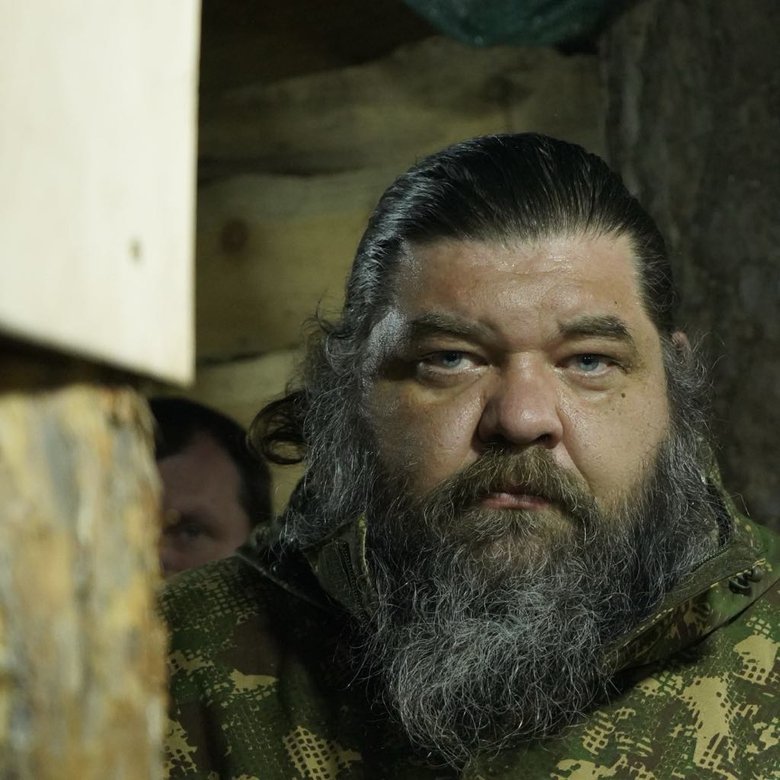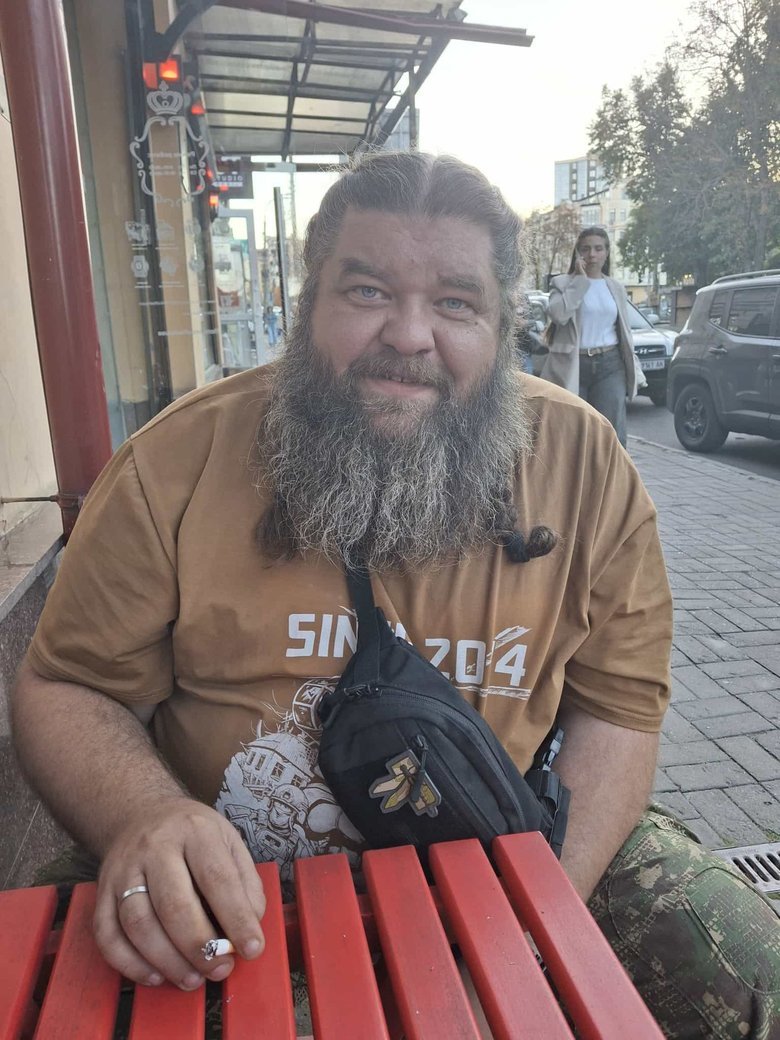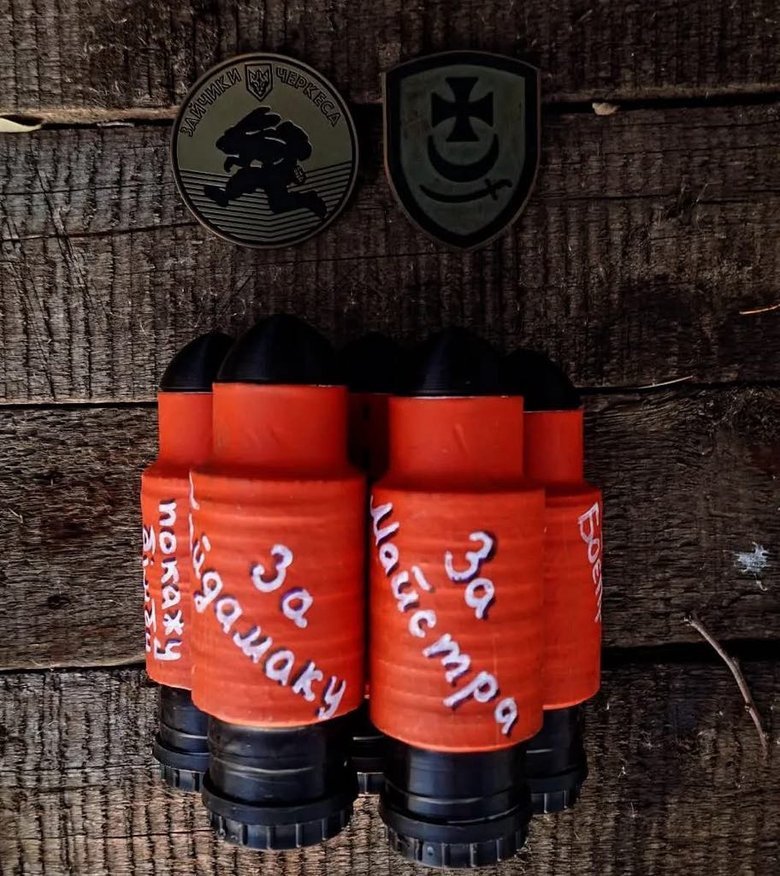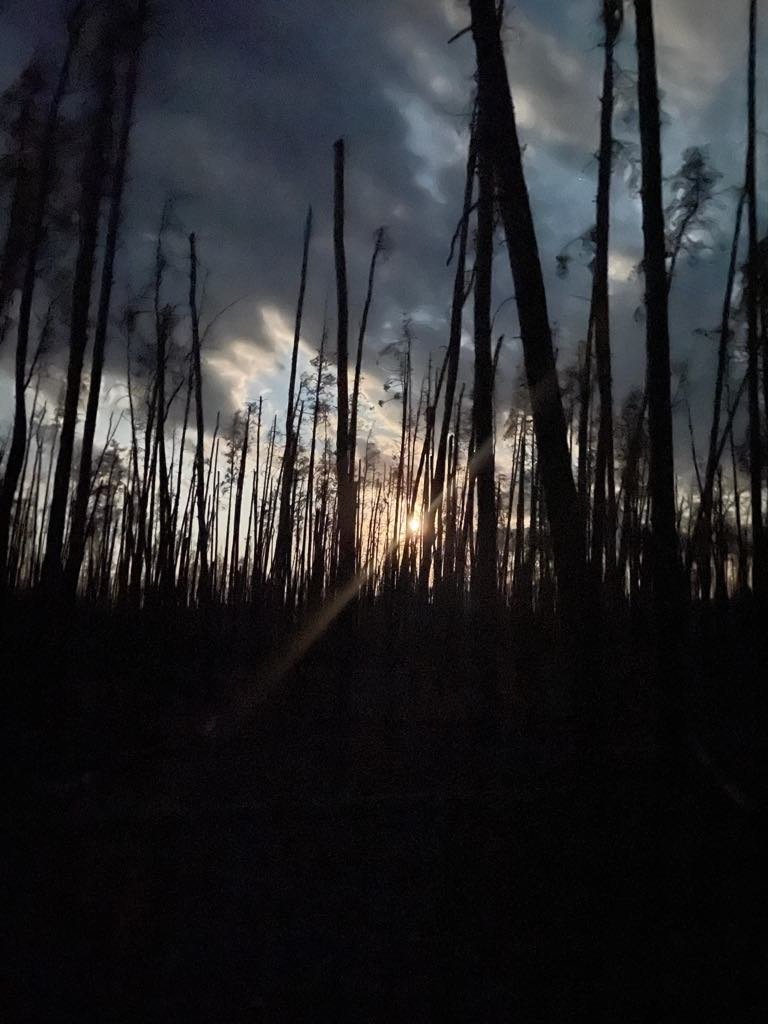Commander of aerial reconnaissance platoon, callsign Baton: "Elimination of apes who came to Ukrainian soil is now taking place daily on industrial scale."
...At the beginning of the war in 2022, he vowed not to shave until Ukraine’s Victory. Since then, Andrii has come to resemble either Gimli from The Lord of the Rings or Hagrid from the Harry Potter series. A Ukrainian Hagrid of sorts, defending his land from the evil creeping in from the north.
Putting literary associations aside, 38-year-old Sumy resident Andrii Bukin, callsign Baton, is one of those our resistance against the aggressor rests on. He volunteered from 2014, then fought in 2015–16, and since the start of the full-scale invasion has been at the forefront of Ukraine’s aerial reconnaissance. He is currently serving in the National Guard assault brigade "Burevii".
- You serve as the commander of the aerial reconnaissance platoon of a separate special-purpose company for technical reconnaissance assets. Explain, for readers unfamiliar with this, what the company and your unit do.
- The reconnaissance company is responsible for collecting and processing analytical data gathered by various assets along the front-line sector where the brigade is deployed. We work with information from multiple services and units that produce different kinds of outputs. For example, radar reports, radio intercepts, prisoner interrogation results, and data collected by aerial reconnaissance. My focus is the aerial reconnaissance platoon, which gathers battlefield information, analysts then use that data to shape the strategy for how to employ it going forward.
- But do you also engage enemy targets?
- That's almost optional for us. Our primary task is reconnaissance.
- As I understand it, the collection of intelligence among the available UAVs is handled by "Leleka" and "Chaklun."
- …and also Mavics and various types of fixed-wing platforms.
- Your subordinates' duties are, on the one hand, a lot of listening, sitting and monitoring. And on the other, working directly in the field. So my question is: how much sleep do people in your unit get?
- It depends on the period, the sector of the front, and the workload. On average, it's a normal working day. A normal working day. They have the opportunity to rest for up to eight hours. But when we're talking about an attack, a flank breakthrough, or operational work that had to be done yesterday, rest time is reduced.
- Any extreme measures to stay awake, like mixing energy drinks and coffee, gone already?
- What? Almost everyone drinks energy drinks plus coffee. Energy drinks, Snickers, they're the fuel of war!
- What will they drink when the war, God willing, finally ends?
- I can't even imagine.
- The intelligence collection part is clear: you gather data with UAVs and pass it up the chain. But what about your secondary role? What are the typical targets inside the enemy’s positions?
- I should note that the brigade’s workflow is set up very efficiently. When we identify a target, we try to strike it immediately. This, of course, applies to the forward edge, the immediate line of contact. In other words, there’s none of the 2022 scenario where we’d spot someone, report it, and then someone only starts striking a day later or where we spend half a day hunting for strike assets.
IEDs are improvised explosive devices for various purposes. The beginning.
IEDs in revenge for the fallen comrades, Maistre and Haidamak
Today we can state the fact that when a reconnaissance drone sees any movement (infantry, vehicles, missile systems, anything), or enemy cover, or enemy wings taking off, it is hit right then and there. That is, the fpv units that are on combat duty in this lane immediately equip the drone with a warhead and fly out to engage.
Baton: "And here on the ground a Katsap soldier is pretending to be dead. The FPV lands right on him to make sure he’s actually dead."
- But this requires a very well-functioning feedback loop?
- In fact, that workflow is already in place, thanks in part to our unit. We've been trained up to fight. It’s not like someone deliberately let an enemy go, or that we spotted someone and didn’t strike. The effort to eliminate the enemy runs around the clock, across the entire brigade and using multiple means.
- Can the intelligence you collect be used immediately, or is it fed into a database to be used later?
- Analysts have tricks. For example, accumulation. We direction-find clusters of interesting signals emitted by people using modern tools. An analyst then compiles daily enemy routes over the past month and a half. Say we don’t have visual accumulation at a given point—but there are various technical indicators that confirm, for instance, there is a passage (and technically it’s a specific spot, a house, or a dugout) where the enemy emits certain signals using their equipment. Accordingly, the analyst produces a condensed extract and passes it to reconnaissance: "we’ve detected this." Most likely it’s a shelter, and, for example, a concentration of assault elements is located there. They’re using these particular systems.
- So you’ve received that information. What’s the logic of action next?
- Confirmed analyst reports go to the decision-making center, that is, the brigade headquarters. They decide on striking that target by various means, depending on the type of shelter: a house or cellar, an earth-covered emplacement, a culvert, a bridge, and so on.
I recently posted a video on social media showing the strike on a concentration at a farm.
It was like this: we had been observing the accumulation of enemy infantry in one of the hangars for several days. But we could not reach it. Besides, the hangar was so big that an FPV could not do anything there. So a decision was made at the brigade level. They requested an airstrike, and that airstrike killed up to 20 people inside the hangar. This is a vivid illustration of the work of analysts in coordination with the headquarters and neighbouring units.
- How many people are in your platoon and what is the average age of these people?
- I won't say how many. The age range is from 22 to 45. Most of them are 30+.
- Are they experienced drone pilots? Do you have to teach or retrain anyone?
- We are constantly on the contact line. So even if a person comes in untrained, they take a crash course in the unit in 2 weeks. And then, under the supervision of instructors, they are sent to combat. In a month, he is already a professional specialist who knows how to, can, and is able to.
Wing crew. Morning hunt for the enemy. Kupiansk direction, 2025
- So theoretical training is immediately combined with practical training?
- Yes, it does. The advantage is that the pilots have so much flying time that it's hard for anyone to surpass them in a year, including instructors in Kyiv who teach certain piloting sciences.
- You have been involved in aerial reconnaissance since the beginning of the full-scale war. You have seen how everything was built and changed. So you can predict the near and medium-term future. Everyone recognises that this war has turned from an artillery war into a UAV war. So in which direction will this entity evolve?
- I'd like to quote some statistics. Last year, from August to January, 98% of all casualties along the contact line of our brigade were caused by fpv. Accordingly, we can state that a cheap copter with the right projectile has revolutionised military strategy.
The future is very vague. Both we and the enemy are using the same means, more or less. It's just that someone is running ahead in certain processes, someone is lagging behind. Someone is paying more attention to some other things. What is the problem? The problem is that both we and they are trying to cut logistics routes. And if last year and the year before that the most dangerous part of the frontline was the front trenches where the infantry lived (let's say my conditional position was 300 to 500 metres from the immediate ground zero, and it was considered to be at a relatively safe distance), now the most dangerous job is probably logistics, or a driver who delivers and takes out certain supplies. You can be hit either right next to the infantry on the immediate edge or up to 20 km in the rear.
- In a recent article by Zaluzhnyi in Dzerkalo Tyzhnia, there is a fragment about how the concept of the rear will gradually disappear in this war as UAVs come to the fore. Because the parties will be able to reach tens of kilometres beyond the line of contact with drones. So what is the rear to do? Sit in shelters and build new shelters? In our native Sumy region, the military is already recommending that people in entire districts refrain from travelling because enemy drones are watching the roads...
- I do not have such hyper-pessimistic forecasts. In fact, everything is predictable. Everyone knew about it a year ago, when the Kursk operation was ending; that, in fact, the monkeys focused on cutting off logistics, and they use two types of means for this. These are Molniya-2 and fibre-optic fpv. What is happening on the frontline now is not something they came up with a month ago. This is planned, and we talked about it. The headquarters knew about it. The administrations knew about it. Accordingly, if we know what strategy will be used against us, we can build appropriate defences for ourselves. In order to ensure efficient logistics, we need to build protective corridors. First of all, this is something that can be done directly.
- Are the protective nets that are being stretched over our roads effective?
- They are effective, but they need to be stretched on time and with high quality. And they also need to be patched in time, because a fibre-optic drone can look into any hole that remains in the mesh.
- Let's give a quick primer for readers who aren't familiar. What are fiber-optic tethered drones?
- It's a platform directly controlled by a pilot via a sort of tether. It's an extremely thin fiber-optic line that runs from the pilot to the drone, which carries a combat payload. The operational range of such drones is already 15–20 km. There is information that "Molniya" systems on fiber-optic tethers are being tested, which will use 50 km reels.
- The advantages of this technology are that, first, it completely negates the enemy's EW (electronic warfare) capability, and second, it provides very high-quality imagery. As for drawbacks, they are difficult to operate in poor weather.
- In reality there are many drawbacks. Fiber-optic tethered UAVs are very complex to operate. If the fiber breaks, the system becomes extremely unwieldy. A number of technical conditions must be met for it to reach the target. You can't turn 180 degrees without risking the fiber snapping — you effectively need to make a loop
- The enemy has the best drones with fibre optics, right?
- Yes. They are trying to grow their own fpv pilots who fly fibre optics. They have created schools, training centres, and entire departments that are dedicated to this story. They don't do anything else. Only, for example, cutting the logistics of a particular road. They are only waiting on this road. They are given the task of cutting the logistics here. There can be anything on the sides, but they work on this particular section of the road.
The next story is that they can enter and work to destroy only certain types of positions. For example, where there are mavericks, or where there are storks, or where there are fpvs. They don't touch the infantry at all and don't touch the logistics. They work exclusively on crews.
- Do you also try to take out your counterparts?
- When we find enemy pilots, it is a priority.
- Do they do the same?
- Most likely. Like I said, it varies with them. Some pilots are focused solely on disrupting logistics — they do nothing else. Or they spot a foxhole with a spotter in it and blast it again and again. They don't care who's arriving or leaving.
Serebrianskyi forestry - at the beginning of the military episode - and after another shelling, before the subsequent fire
- The pilot of the Vampire from Dovbush's Hornets, call sign Kolektor, came to talk to me wearing a balaclava. He explained that the pilots and their families might be too fat a target for the Muscovites. Moreover, he was working on enemy pilots.
- I think this is a personal story for everyone. I also believe that we are on a big land in Ukraine - everyone is at risk. Those who work as intelligence officers of various kinds have to walk around and look around. And build their lives in a civilian city, in the rear, so that they can protect themselves and their families.
A fighter with the call sign Tom shows off his interview and photos in The New York Times
- What are the typical personnel positions in your platoon? In the Dovbush Hornets, these are: a UAV operator, a tablet operator (de facto navigator) and a fpv drone technician.
- They are all drone operators. There are no separate navigators.
- Are you striving for universalism?
- That's exactly right. They undergo certain training and then constantly change during their work. Someone works as a first officer, then becomes a second officer. And vice versa.
- Speed and coherence are of primary importance?
- Yes, they are. I remember how in 2022 you could hunt for a Muscovite for a day and a half, and then, when you found him, you would impress him with any means you could conjure up. And the experience was incredible.
And today, the elimination of monkeys that have come to Ukrainian soil takes place on an industrial scale every day. It has become so routine that it is hard to imagine.
Enemy pilots' shelter with a Starlink terminal on the roof. Destruction of the FPV link by a drone.
- Let me ask you about yesterday. How many impressions did your guys have in total?
- Yesterday, my FPV position made 24 combat sorties. It was a daylight day - from six in the morning to the beginning of eight. This is an average day for a fighter pilot. Maverick pilots have an average of 40 to 60 sorties per day. And almost every sortie is either 200 or a dismantled shelter.
- What distances are we talking about?
- We won't name them. Especially since they are very different. Well, let's just say from 1.5 to 25 kilometres. Even up to 40 kilometres, depending on what kind of UAVs we are talking about.
- Are you constantly looking for new personnel, like, for example, the Dovbush Hornets?
- We are looking for people non-stop. We are looking for young people, those who have more than 25 thousand plays on Steam or any console. Those who are sane, do not use drugs or alcohol - we take them with pleasure. We interview them and provide training. We show them all the tricks of the trade.
Serebrianskyi forestry 2024
- Let's get back to how to counteract the logistics rear cut, which is currently being used by the Muscovites.
- In fact, what they have come up with is nothing new. Planes with a range of up to 50 kilometres, fpv on fibre optics. To counter this, we have to build tunnels. Both on the ground and underground. Accordingly, the issue of fortifications, which was hotly debated last year, is still acute. If we build a defence line that is not just a bunch of holes in the centre of the field, but is closed, camouflaged, hidden, and properly constructed, we can work with it. The same applies to frontline regions, which are usually not prepared for defence. In the Sumy region, for example, we need to build up appropriate stationary corridors along all roads. Just like asphalt is laid, so should this thing be laid. There must be a good road, and there must be corridors.
- What tactics do you predict for Russia's shelling of the Ukrainian rear in the coming autumn and winter? One new factor to consider has already emerged: since autumn, they have been hitting retailers' warehouses, warehouses in general. What does this mean?
- I believe that the Muscovites have various scenarios that are lying prepared on the desks of decision-makers. And they have now chosen a certain scenario and will try to implement it. We have already seen their scenarios for eliminating long-range targets. For example, they have been hitting Nova Pochta exclusively. Another scenario was work on the energy structure. For example, the 40th substation in Sumy, energy hubs in Kharkiv, Pisochin, etc.
They make certain moves. Classic Russians: they make a decision and they don't care whether it's right or not. They just take action and keep striking, striking, striking. Then after some time they return to the results and check whether the catastrophe they planned has occurred. Is there catastrophe in the frontline or border cities — Kharkiv, Sumy, Kramatorsk, Sloviansk, Zaporizhzhia, Dnipro, Kyiv? If the power infrastructure hasn't been knocked out, they shift their focus. In other words, there isn't a single chosen storyline. They adopt a scenario and will work to it for a month up to three months (depending on how effective it proves to be.)
Why does this happen? They simply look at themselves and at the damage Ukraine inflicts on them. They can't work out which niche to target to hurt our economy as much as they were hurt by those refineries. We adopted, I don't know when exactly, but obviously at the high command level, a decision to eliminate refineries across Russia. A lot of resources were thrown at that project. A lot. Some 300 to 700 drones launch daily along different axes; importantly, they are piloted by different entities. We don't have a single decision-making center. Multiple groups are operating independently. Even if one unit or a unit commander who makes certain decisions is destroyed, neighboring units that don't belong to that structure but work in entirely different organizations will keep doing the same.
The same applies to the production of long-range UAVs or small quadcopters. It's impossible to strike a single structure and stop it. Even if they collect intelligence, even if they hire someone to observe, detect, report and then an "Iskander" lands on the target, that still won't halt the flow that's coming. That's because very small, loosely organized enterprises across the whole territory of Ukraine are involved in this. The same goes not just for drones but for munitions as well. Munitions are made everywhere, in the bushes, in basements, in market stalls. They would never, ever suspect they're there. And that's our advantage, there is no single center. You can only really strike at the President. And then there's the question of whether he is actually there or not. By contrast, we know all their pressure points. For example, to pick a good example, note the attacks carried out, whether by the Main Intelligence Directorate or the SBU, on fiber-optic manufacturing plants. Brilliant. The strike landed and on the front everything simply stopped flying for three weeks. One plant was hit, everything burned down and that's it. They have to rebuild it. They need to buy a huge batch from the Chinese, bring it in, and re-spool it. That's a major logistics operation.
- Andrii, you're in Kyiv on your way from Kupianske. Did you come to solve the supply issue?
- No, I came here for treatment. My health has failed, I have to have a planned operation.
- Restarted your health? You've been at war since God knows how long.
- I collected a bunch of sores. And it so happened that it is time to start treatment.
- Does it scratch your heart that you are not with your guys now?
- It's crazy.
- But are you in touch with them all the time?
- Yes, all the time. I haven't dropped out of the workflow yet. I try to control, help and be present there, but only remotely.
- Please describe the current state of affairs in the Kupyansk sector.
- I will say in military terms: it is difficult but under control. The biggest trouble was about a month and a half ago, when the enemy launched an active assault on Kupyansk itself. We (Ukraine) lost the initiative and only - this is my personal opinion - only after the assault on Kupyansk was publicised did the situation change somewhat.
- Do you mean the story of the Muscovites who came to us through the pipe?
- The pipe story - in my personal opinion, it was no more than 10% of the personnel who came in. But this story gave an informational reason to talk about Kupyansk. And, in fact, the coverage of the story about Kupyansk gave impetus to the creation of the Kupyansk defence. That's why the situation there is difficult, but they will fight for Kupyansk. And I hope that everything will be more or less settled there.
Damaged enemy equipment. Kupiansk direction
Baton: "Incredible work of the crew of the 4th Battalion of the Burevii Brigade, who jumped out of the ground and shot at enemy positions at close range. And under enemy fire, they manoeuvre their way back to the rear." Kupianske direction, October 2024
- In conclusion, let me ask you this. In 2022, after our successful counter-offensive, I asked you if you believed in our victory. There was a confident answer: yes, I do. Now that the initiative - at least the tactical one - is on the side of the Muscovites, do you still believe in Victory?
- Absolutely, of course.
- Please explain.
- Everything is very simple. This is a war for survival. Those who say that we are tired of the war, of the training camps, of the power cuts or air raids - they do not understand the basic thing: we will either win or be completely destroyed.
The forest of Kreminna near the aerial reconnaissance position. There are only stumps left of the trees...
The fact is that when we said the same thing 20 years ago - that Moscow has imperial plans, that it is going to attack us and then Europe - we were really considered crazy. We were a fringe group.
- Yeah, stupid, pompous nationalists.
- Yes, we were. Now these are obvious stories. We can look at our occupied territories - Kherson and Zaporizhzhia regions. Everyone has already been cleared out of Melitopol. Even those who went over to their side while on patrol have been taken prisoners. They have all been taken away and moved on.
That's why it's a war for survival. It is only a matter of time before the Muscovites have some tactical advantages at the front. We need to focus on destroying the infantry. And as the commander of the BSF Magyar says, we need to kill 43,000 of them a month. So far, we are killing "only" 30,000 a month.
The NGU commander presents Andrii Bukin with the Order for Courage, III class.
Attention: Those wishing to help Andrii Bukin and his unit can use the following information:
🔗Bank links
https://send.monobank.ua/jar/2QYs7iEXXE
💳Bank card number
4874 1000 2882 9714
Yevhen Kuzmenko, "Censor.NET"
Video, photos: Andrii Bukin














